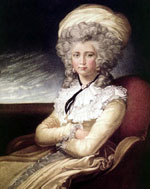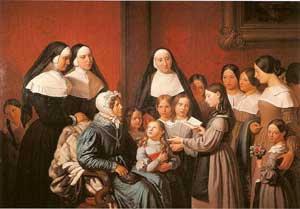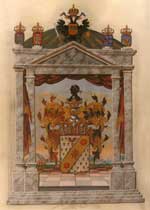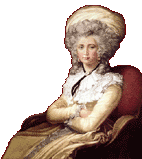In all the great things we undertake
are the small ones that bother us
(Maria Cosway)
Maria Luisa Caterina Cecilia Hadfield or Madame Cosway, this is how she preferred to be called, was born in Florence on the 11th of June 1760 (this date is not documented but it's likely to be exact). Her father Charles Hadfield was a rich merchant from Manchester, that moved to Tuscany to run several hotels that mainly accomodated English tourists.
 This fair little English girl, with big bright blue eyes, has sailed pleasantly and skilfully, through the stormy world of her time, which was agitated by great and upsetting reversals: and she managed to achieve it like an experienced traveller – as it occurs for English people - leaving Florence, her native town, for England, her real homeland; from “enlightened” and revolutionary France – first Jacobean and then Napoleonic – to Austria under the Restauration, till the arrival, when middle-aged, in Lodi, the smallest one among the towns, she fully demonstrates her talents as educator, already tested in Lyon, where she opened a lay college for young women and that will become after – while the Founder was still alive – the Religious Institute for English Ladies (From the introduction of Age Bassi to the volume of E. Cazzulani e A. Stroppa, Mary Hadfield Cosway. Biografia, diari e scritti della fondatrice del Collegio delle Dame Inglesi in Lodi, L'Immagine, Lodi, 1989).
This fair little English girl, with big bright blue eyes, has sailed pleasantly and skilfully, through the stormy world of her time, which was agitated by great and upsetting reversals: and she managed to achieve it like an experienced traveller – as it occurs for English people - leaving Florence, her native town, for England, her real homeland; from “enlightened” and revolutionary France – first Jacobean and then Napoleonic – to Austria under the Restauration, till the arrival, when middle-aged, in Lodi, the smallest one among the towns, she fully demonstrates her talents as educator, already tested in Lyon, where she opened a lay college for young women and that will become after – while the Founder was still alive – the Religious Institute for English Ladies (From the introduction of Age Bassi to the volume of E. Cazzulani e A. Stroppa, Mary Hadfield Cosway. Biografia, diari e scritti della fondatrice del Collegio delle Dame Inglesi in Lodi, L'Immagine, Lodi, 1989).
Maria Cosway has been one of the most fascinating feminine personalities who lived between the XVIII and XIX century, she has been defined as an affable beauty and fully talented. Maria was a writer, a painter, a singer, a musician (she played the harp and the organ) and a composer, and finally also an educator of civil donzelle. She was a delicate woman, very attractive and her beauty caused misunderstandings in some important relationships.
She had a complex and cultured personality, with many intuitions that were sustained by ambitious initiatives together with passions and ideals, satisfactions and worries, but also hardships; therefore a full-relief figure, that can't be restricted to few details picked up from some anecdote... ... Hers, had been an intense life, as it was always developing between plans and destiny and in advance with her time. She had been a Member, since 1778, of the glorious Art Academy in Florence; founder of an education house for young women, first in Lyon and then in Lodi; ... ... Baroness in 1834, ... in contact and in relationship with the protagonists of History, with a capital letter.
The aims of Maria to become independent as a painter, had been denied by her husband, Richard Cosway, who limited her potentials in preventing her also from selling her paintings. From 1781 to 1789 she exhibits thirty-one paintings1 at the Royal Academy, a site where the exhibitions of the best artists were shown. (Maria e Richard Cosway, edited by Tino Gipponi, Umberto Allemandi & C., Torino 1998)
Maria, since she was young, showed herself to be a talented musician playing the harp, the organ and the harpsichord. After her wedding (1781), Maria wasn't allowed to continue professional music for it was considered unsuited to a high social class woman. In spite of this, she managed to acquire wide consents with several publications that were known as “to Lady” or “to Madame”. A composition by Maria, Songs and Duets, had been sent to Jefferson just after his return to US from Paris. We can find copies of this composition at the Performing Arts Library of New York, the National Library in Paris and Monticello in Virginia.
Maria's musical work remains, for the most, a mystery. On the other hand, it is well-known that Cosway used to play and sing her own compositions during her “Grand Concerts”, that she used to give at her home in London.
Maria Cosway has been a woman truely committed also on the side of female education. After her husband's death, she lived her middle-age in Lodi.
 Here she had the chance to found again an educational female institute, that had been set up in Lyon during the Napoleonic years, giving life to the Beata Vergine delle Grazie College. The College became famous as the Real Collegio delle Fanciulle of Milan; these were the only two institutes mentioned by the Irish traveller Sidney Owenson Morgan (Lady Morgan) and by the general inspector of primary education, the Canon Giovanni Palamede Carpani, who wrote (1823) that the College was an establishment that honoured the country, and also already acknowledged by the Royal Imperial Government.
Here she had the chance to found again an educational female institute, that had been set up in Lyon during the Napoleonic years, giving life to the Beata Vergine delle Grazie College. The College became famous as the Real Collegio delle Fanciulle of Milan; these were the only two institutes mentioned by the Irish traveller Sidney Owenson Morgan (Lady Morgan) and by the general inspector of primary education, the Canon Giovanni Palamede Carpani, who wrote (1823) that the College was an establishment that honoured the country, and also already acknowledged by the Royal Imperial Government.
The girls were divided into three classes, according to their age and their level of instruction; they were taught Italian, calligraphy, mathematics, history, geography as well as the rules in accordance with social behaviour and social life. There was also religious and moral education. French language, drawing, music and dance classes were considered optional teachings .
Cosway herself, while introducing the College aims, declared that her purpose was to form good family mothers able to bring up children and create a good impression in society.
 On the 14th of November to Maria is granted, by the Emperor Francesco I , the title and the rank of Baroness, in recognition of the credits acquired during her activity as an educator.
On the 14th of November to Maria is granted, by the Emperor Francesco I , the title and the rank of Baroness, in recognition of the credits acquired during her activity as an educator.
Maria Cosway on the 5th of January 1838, at sunset, dies in Lodi and she rests in the church of Santa Maria delle Grazie in Lodi. Her remains had been preserved for a short time in the graveyard of San Fereolo in Lodi and on the 6th of November of the same year transferred, as she had wished, into the church of delle Grazie.
Previously Maria had expressed the desire to be buried in her villa in Blevio on the lake of Como.
![]()
Fondazione Maria Cosway Via Paolo Gorini, 6 26900 Lodi C.F. 84511920153

